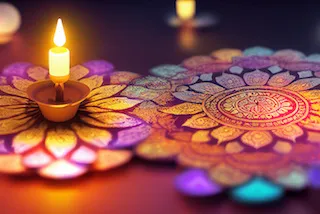
Diwali In Yoga
Posted by Feride on Monday, 20 October 2025
4 min read
Although preparations start many days beforehand, Diwali 2025 celebrations begin today, 20 October and traditionally last for five days. I thought it would be nice to reflect this in my yoga session last Friday, especially given that both yoga and Diwali originated in India.
The word ‘Diwali’ (Deepvali) is Sanskrit and is translated as ‘a row of lights’. In England, we often refer to Diwali as the ‘festival of lights’. Recognised all around the world by Hindus, Sikhs and Jains, it is a celebration symbolising the spiritual victory of Dharma over Adharma, light over darkness, good over evil, and knowledge over ignorance.
Diwali has many stories and celebrations according to the region in India. The exact date of the annual celebration can change as it is based on the cycle of the moon, but it is always between October and November each year. A time of rejoicing with family and friends. Earthen lamps are lit in rows along the houses, streets and temples. For Hindus, the lamps represent the homecoming of Lord Rama to Ayodhya after a 14-year exile, following his defeat of the demon King Ravana. People of Ayodhya lit lamps along the way to light their path in the darkness.
Rangolis are also seen at the front of homes, (beautiful intricate designs made from rice flour, coloured sand and flower petals), placed to invoke deities like the Goddess Lakshmi, the goddess of wealth but also to bring good fortune and ward off evil. In Jainism, Diwali is celebrated as the day of spiritual awakening, when the last of the Jain Tirthankaras, Lord Mahavira, attained nirvana. For the Sikhs, Diwali celebrates the victory and freedom of the sixth guru, Guru Hargobind, from Emperor Jahangir, representing the triumph of righteousness and freedom.
Celebrations today, include lovely meals and delicious cakes which are often exchanged between family and friends, encouraging the importance of unity. Past issues are forgiven, settled and not taken into the following year as hope, forgiveness and compassion is encouraged.
On a spiritual level, Diwali is a time of renewal, reflection, and celebration, symbolising the triumph of light and goodness in the world. A time to reflect inwards and embrace our own inner light, releasing negative emotions or habits that no longer serve us and making energetic space for personal forgiveness and transformation. Allowing our own internal light to shine through and making time to self-inquire of our own thoughts and actions, past and present, so that we begin the process of self-transformation. Learning what we ‘are not’ and understanding how we can be more loving kind and respectful not just to others but also to ourself. To shine our own light into the world and illuminate empathy in our hearts.
Taking the threads of Diwali into my yoga session this week began with symbolising the theme of light with the Tejas Mudra. This mudra pattern resembles an upward pointing flame and as Diwali allows us to look forward into the coming year, we can focus on this mudra to appreciate being in the present moment, practicing gratitude for what we have, and as a flame points upwards, us to look forward into the coming year. Held in front of our heart centre, Tejas Mudra invites us to remember the light and brilliance that is already alive in our True Self.
A gentle yoga sequence followed with asanas set in a positive and peaceful tone. We focused on our pranayama (breathwork), using breath to movement in asana, inviting us to pause and reconnect as well helping to cultivate a sense of serenity in mind and body. Asanas included symbolic themes of light and balance, with Utthita Tadasana (Star Pose) representing the guiding light of Diwali and creating balance for all the chakras of the body and allowing prana to flow throughout. Urdhva Hastasana, (volcano pose) representing the fireworks during Diwali celebrations and also aiding in increasing our prana vayu and energising our throat chakra, the centre of communication. We did various Virabhadrasana (warrior poses), aligning with the theme of Lord Rama, for the strength to overcome dark over light and also heart opening poses to forgive and shine inner light outward. And finally of course, Natarajasana, (Lord Of The Dance Pose) representing the joyful celebrations.
We closed our yoga session with a guided light visualisation, sharing the connection of stillness and reflection.
Yoga and Diwali have a natural synergy as both traditions help us embrace our own spiritual connection and inner transformation. The spiritual connection to Diwali allows us to understand the True Self, focusing on our own flame of awareness, bringing clarity, compassion, forgiveness and knowledge.
Happy celebrations everyone. xx
Back to Blog